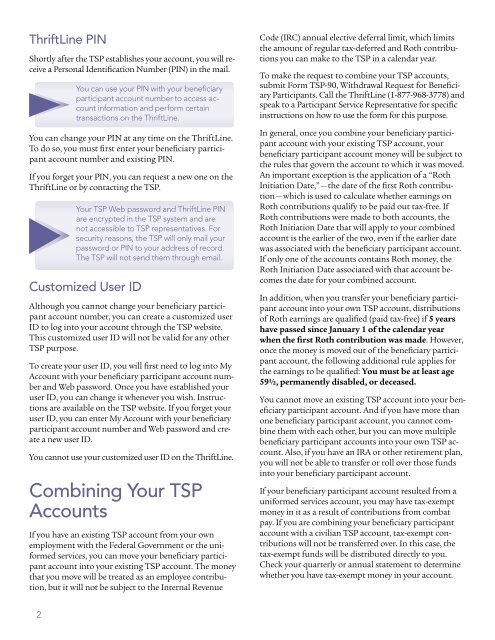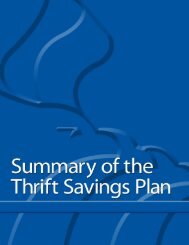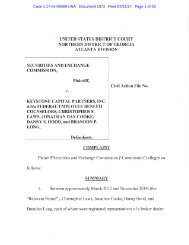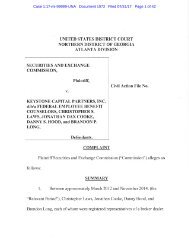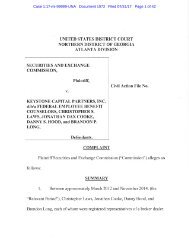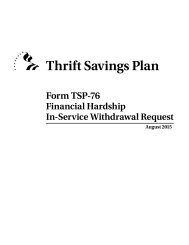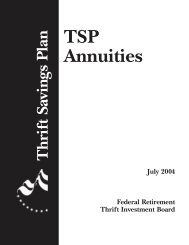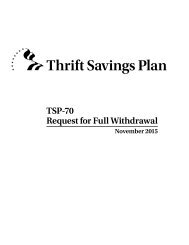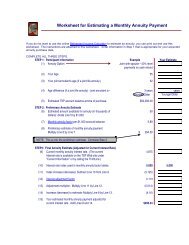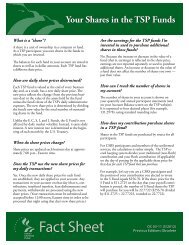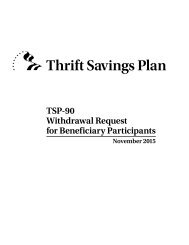tspbk33
You also want an ePaper? Increase the reach of your titles
YUMPU automatically turns print PDFs into web optimized ePapers that Google loves.
ThriftLine PIN<br />
Shortly after the TSP establishes your account, you will receive<br />
a Personal Identification Number (PIN) in the mail.<br />
You can use your PIN with your beneficiary<br />
participant account number to access account<br />
information and perform certain<br />
transactions on the ThriftLine.<br />
You can change your PIN at any time on the ThriftLine.<br />
To do so, you must first enter your beneficiary participant<br />
account number and existing PIN.<br />
If you forget your PIN, you can request a new one on the<br />
ThriftLine or by contacting the TSP.<br />
Your TSP Web password and ThriftLine PIN<br />
are encrypted in the TSP system and are<br />
not accessible to TSP representatives. For<br />
security reasons, the TSP will only mail your<br />
password or PIN to your address of record.<br />
The TSP will not send them through email.<br />
Customized User ID<br />
Although you cannot change your beneficiary participant<br />
account number, you can create a customized user<br />
ID to log into your account through the TSP website.<br />
This customized user ID will not be valid for any other<br />
TSP purpose.<br />
To create your user ID, you will first need to log into My<br />
Account with your beneficiary participant account number<br />
and Web password. Once you have established your<br />
user ID, you can change it whenever you wish. Instructions<br />
are available on the TSP website. If you forget your<br />
user ID, you can enter My Account with your beneficiary<br />
participant account number and Web password and create<br />
a new user ID.<br />
You cannot use your customized user ID on the ThriftLine.<br />
Combining Your TSP<br />
Accounts<br />
If you have an existing TSP account from your own<br />
employment with the Federal Government or the uniformed<br />
services, you can move your beneficiary participant<br />
account into your existing TSP account. The money<br />
that you move will be treated as an employee contribution,<br />
but it will not be subject to the Internal Revenue<br />
Code (IRC) annual elective deferral limit, which limits<br />
the amount of regular tax-deferred and Roth contributions<br />
you can make to the TSP in a calendar year.<br />
To make the request to combine your TSP accounts,<br />
submit Form TSP-90, Withdrawal Request for Beneficiary<br />
Participants. Call the ThriftLine (1-877-968-3778) and<br />
speak to a Participant Service Representative for specific<br />
instructions on how to use the form for this purpose.<br />
In general, once you combine your beneficiary participant<br />
account with your existing TSP account, your<br />
beneficiary participant account money will be subject to<br />
the rules that govern the account to which it was moved.<br />
An important exception is the application of a “Roth<br />
Initiation Date,” — the date of the first Roth contribution<br />
— which is used to calculate whether earnings on<br />
Roth contributions qualify to be paid out tax-free. If<br />
Roth contributions were made to both accounts, the<br />
Roth Initiation Date that will apply to your combined<br />
account is the earlier of the two, even if the earlier date<br />
was associated with the beneficiary participant account.<br />
If only one of the accounts contains Roth money, the<br />
Roth Initiation Date associated with that account becomes<br />
the date for your combined account.<br />
In addition, when you transfer your beneficiary participant<br />
account into your own TSP account, distributions<br />
of Roth earnings are qualified (paid tax-free) if 5 years<br />
have passed since January 1 of the calendar year<br />
when the first Roth contribution was made. However,<br />
once the money is moved out of the beneficiary participant<br />
account, the following additional rule applies for<br />
the earnings to be qualified: You must be at least age<br />
59½, permanently disabled, or deceased.<br />
You cannot move an existing TSP account into your beneficiary<br />
participant account. And if you have more than<br />
one beneficiary participant account, you cannot combine<br />
them with each other, but you can move multiple<br />
beneficiary participant accounts into your own TSP account.<br />
Also, if you have an IRA or other retirement plan,<br />
you will not be able to transfer or roll over those funds<br />
into your beneficiary participant account.<br />
If your beneficiary participant account resulted from a<br />
uniformed services account, you may have tax-exempt<br />
money in it as a result of contributions from combat<br />
pay. If you are combining your beneficiary participant<br />
account with a civilian TSP account, tax-exempt contributions<br />
will not be transferred over. In this case, the<br />
tax-exempt funds will be distributed directly to you.<br />
Check your quarterly or annual statement to determine<br />
whether you have tax-exempt money in your account.<br />
2


